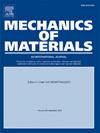数据驱动计算力学的动态自适应采样策略:在计算均匀化中的应用
IF 3.4
3区 材料科学
Q2 MATERIALS SCIENCE, MULTIDISCIPLINARY
引用次数: 0
摘要
为了克服非线性非均质材料的经典现象学本构建模的众所周知的缺点,一种流行的方法是所谓的计算均质化(CH),它依赖于本构行为和较小尺度成分的空间形态的组合描述。它们的计算实现通常包含两级有限元数值模型(FE2),这很快就会导致令人望而却步的计算成本,即使对于具有适度自由度的问题也是如此。文献中减轻这种计算负担的一种流行策略是使用基于机器学习的代理本构模型,尽管仍然存在诸如缺乏可解释性、有限的外推能力和有限的数学分析等基本缺陷。另一方面,所谓的(无模型)数据驱动计算力学(DDCM)范式Kirchdoerfer和Ortiz(2016)提出直接整合“实验数据”,完全绕过了对显式本构律的需要。这项工作的主要目标是展示DDCM方法如何与CH协同使用,以绕过完全耦合的多尺度计算。使用多尺度本构行为和DDCM的一种朴素方法是通过假设应变空间的一些采样,通过CH离线构建数据库。这种方法没有什么意义,因为在模拟过程中所覆盖的应变空间区域是与问题相关的。在DDCM求解器的迭代过程中,使用有限的应变-应力对集作为输入,同时动态生成包含机械允许状态的另一组应变-应力对集。这样的场景自然地揭示了最相关的面向目标的相空间实例,以指导材料数据集丰富迭代过程,将DDCM和CH连接到计算有效的双尺度模拟。另一方面,如果机械允许状态的质量较低,特别是当材料数据集不够密集时,性能就会受到限制。为了解决这些挑战,我们提出了有意义的排名分数和数值技术,以增强稀疏数据场景下的DDCM求解器。因此,我们通过有意义的数值例子表明,与标准FE2相比,所提出的框架可以显著节省计算量。本文章由计算机程序翻译,如有差异,请以英文原文为准。
On-the-fly adaptive sampling strategy for data-driven computational mechanics: Applications to computational homogenisation
To overcome well-known drawbacks of classical phenomenological constitutive modelling of non-linear heterogeneous materials, a popular approach is the so-called computational homogenisation (CH), which relies on a combined description of constitutive behaviours and spatial morphology of smaller scales constituents. Their computational implementation usually encompasses two-level finite element numerical models (FE), which quickly leads to prohibitive computational costs, even for problems with a modest number of degrees of freedom. A popular strategy in the literature to alleviate such computational burden is to use machine learning-based surrogate constitutive models, although fundamental drawbacks such as the absence of interpretability, limited extrapolation capability, and limited mathematical analysis, are still present. On the other hand, the so-called (model-free) data-driven computational mechanics (DDCM) paradigm Kirchdoerfer and Ortiz (2016) proposes the direct integration of “experimental data”, completely bypassing the need for explicit constitutive laws. The main goal of this work is to show how the DDCM approach can be used in synergy with CH to bypass fully-coupled multiscale computations. A naive approach to using multiscale constitutive behaviour along with DDCM is the offline construction of a database via CH by assuming some sampling of the strain-space. This approach has little interest since the region of the strain-space covered during a simulation is problem-dependent. During the iterations of the DDCM solver, a finite set of strain–stress pairs is used as input, while another set, comprising mechanically admissible states, is dynamically generated. Such a scenario naturally unveils the most relevant goal-oriented phase-space instances to guide a material dataset enrichment iterative procedure, bridging DDCM and CH towards computationally effective two-scale simulations. On the other hand, the performance is limited if the quality of the mechanically admissible states is low, particularly when the material dataset is not insufficiently dense. To address these challenges, we propose meaningful ranking scores alongside numerical techniques to enhance the DDCM solver in sparse data scenarios. As result, we show through meaningful numerical examples that the proposed framework results in significant computational savings if compared to standard FE.
求助全文
通过发布文献求助,成功后即可免费获取论文全文。
去求助
来源期刊

Mechanics of Materials
工程技术-材料科学:综合
CiteScore
7.60
自引率
5.10%
发文量
243
审稿时长
46 days
期刊介绍:
Mechanics of Materials is a forum for original scientific research on the flow, fracture, and general constitutive behavior of geophysical, geotechnical and technological materials, with balanced coverage of advanced technological and natural materials, with balanced coverage of theoretical, experimental, and field investigations. Of special concern are macroscopic predictions based on microscopic models, identification of microscopic structures from limited overall macroscopic data, experimental and field results that lead to fundamental understanding of the behavior of materials, and coordinated experimental and analytical investigations that culminate in theories with predictive quality.
 求助内容:
求助内容: 应助结果提醒方式:
应助结果提醒方式:


